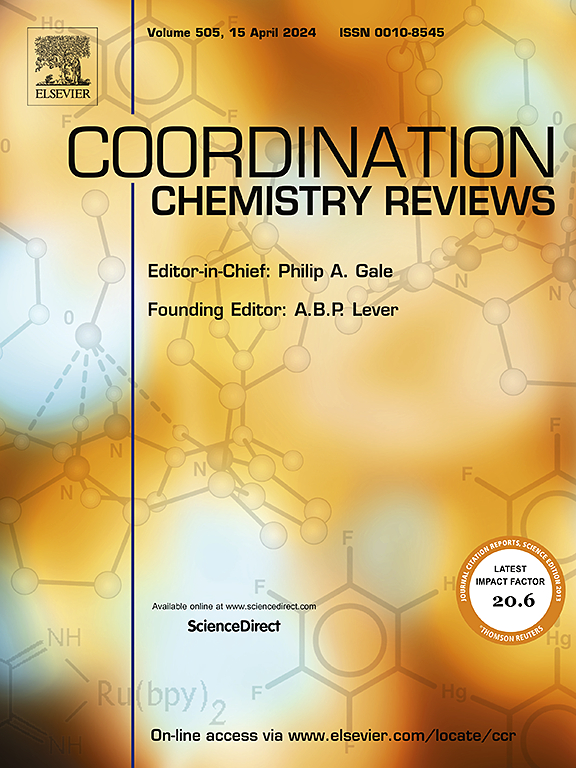Recent advancements in the design and application of Thioctic acid-based self-assembled materials
IF 20.3
1区 化学
Q1 CHEMISTRY, INORGANIC & NUCLEAR
引用次数: 0
Abstract
Thioctic Acid (TA), as an endogenous multifunctional molecule, has become a research focus in the field of self-assembled materials due to its dynamic disulfide bonds, amphiphilic structure, and carboxyl reactive sites. This article systematically reviews the preparation methods of TA-based self-assembled materials and their application progress in various fields. The ring-opening polymerization (ROP) of TA (thermally initiated, photo-initiated, ion-induced, etc.) forms a dynamic poly (TA) network, endowing the material with reversible crosslinking and self-healing properties. In terms of application fields, TA-based materials exhibit unique advantages: 1) In the biomedical field, its antioxidant and anti-inflammatory properties, along with drug-controlled release capabilities, synergistically promote wound repair, neuroprotection, and tumor-targeted therapy. 2) In analytical detection, the coordination properties of TA with metals are utilized for the detection of heavy metal ions. 3) In battery energy, the polymer network of TA can enhance the cycle stability of devices. 4) In the field of intelligent devices, flexible devices are highly regarded in human-machine collaboration and sensing. 5) In environmental protection, TA-based adsorbents efficiently remove water pollutants through coordination effects. 6) In other fields, TA is used as raw materials for 3D printing, adhesives, and modifiers. Additionally, by introducing functional groups to structurally modify TA, the application of its derivatives can be further expanded in scenarios such as underwater adhesives and antibacterial coatings. By showcasing the diverse applications and promising potential of these materials, we aim to inspire further exploration into novel territories, offering valuable insights for the development of TA-based self-assembly materials in untapped fields.
硫辛酸基自组装材料的设计与应用研究进展
硫辛酸(Thioctic Acid, TA)作为一种内源性多功能分子,因其具有动态二硫键、两亲性结构和羧基反应位点而成为自组装材料领域的研究热点。本文系统地综述了ta基自组装材料的制备方法及其在各个领域的应用进展。TA的开环聚合(ROP)(热引发、光引发、离子诱导等)形成动态聚(TA)网络,使材料具有可逆交联和自愈性能。从应用领域来看,ta基材料具有独特的优势:1)在生物医学领域,ta基材料具有抗氧化和抗炎的特性,以及药物控释能力,协同促进伤口修复、神经保护和肿瘤靶向治疗。2)在分析检测中,利用TA与金属的配位特性对重金属离子进行检测。3)在电池能量方面,TA的聚合物网络可以增强器件的循环稳定性。4)在智能设备领域,柔性设备在人机协作和传感方面受到高度重视。5)在环保方面,ta基吸附剂通过协同作用有效去除水体污染物。6)在其他领域,TA被用作3D打印、粘合剂和改性剂的原材料。此外,通过引入官能团对TA进行结构修饰,可以进一步扩大TA衍生物在水下胶粘剂、抗菌涂料等领域的应用。通过展示这些材料的不同应用和前景潜力,我们的目标是激发对新领域的进一步探索,为未开发领域中基于ta的自组装材料的发展提供有价值的见解。
本文章由计算机程序翻译,如有差异,请以英文原文为准。
求助全文
约1分钟内获得全文
求助全文
来源期刊

Coordination Chemistry Reviews
化学-无机化学与核化学
CiteScore
34.30
自引率
5.30%
发文量
457
审稿时长
54 days
期刊介绍:
Coordination Chemistry Reviews offers rapid publication of review articles on current and significant topics in coordination chemistry, encompassing organometallic, supramolecular, theoretical, and bioinorganic chemistry. It also covers catalysis, materials chemistry, and metal-organic frameworks from a coordination chemistry perspective. Reviews summarize recent developments or discuss specific techniques, welcoming contributions from both established and emerging researchers.
The journal releases special issues on timely subjects, including those featuring contributions from specific regions or conferences. Occasional full-length book articles are also featured. Additionally, special volumes cover annual reviews of main group chemistry, transition metal group chemistry, and organometallic chemistry. These comprehensive reviews are vital resources for those engaged in coordination chemistry, further establishing Coordination Chemistry Reviews as a hub for insightful surveys in inorganic and physical inorganic chemistry.
 求助内容:
求助内容: 应助结果提醒方式:
应助结果提醒方式:


